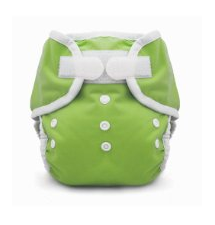What kind of cloth diapers do you use?
There are so many choices when it comes to cloth diapering now, and most of them involve snaps or Velcro instead of pins. There are pros and cons to all of them. We’ve tried a few options and we’ve decided what works for us, but every family is different so here’s the basic rundown of the different types. Within each type there are several brands and variations.
Prefolds and Flats
Prefolds and flats are the most basic kinds of diapers. Flats are just that, a flat piece of cloth that requires folding and pinning and a waterproof cover. Prefolds take a little bit of the work out of cloth diapering because, like the name suggests, they are already folded so that there is more absorpent material in the center. Mamas who use prefolds still have to wrap them around the baby somehow and fasten them. Besides the steeper learning curve, other disadvantages of prefolds and flats are that they take extra time to fold and diaper changes also take longer. However, prefolds and flats are easy to wash, easy to dry and they are the most economical option.
We have some prefolds in our collection. We use them on the days we are really behind on washing diapers. I don’t actually fasten them to my daughter; I just lay them in the cover and let the cover hold them up.
Fitted
Fitted diapers also require a wrap or a cover, but they have elastic around the legs and often fasten with snaps or Velcro. Generally, they cost more than prefolds, but they take some of the work out of diaper changes. There’s also a hybrid diaper called a prefold-fitted that is basically a prefold diaper with elastic sewn around the legs for a snug fit.
We recently added two fitted diapers to our stash for overnight use. When our daughter started wetting through her diaper at night, I did some research about the most absorbent diapers and purchased a few fitteds to try. They work really well but not any better than triple stuffing a pocket diaper with a microfiber insert and two hemp inserts for extra absorbency. Still, some people swear by fitteds.
All-In-One
All-in-one (AIO) diapers are aptly named. They are the cloth diapering option that is closest to disposables. AIOs do not require a separate absorbent material (often called a soaker) or a separate waterproof cover. AIO cloth diapers are easy to use, but they require longer drying times which may mean you need to purchase more of them than other options, and they are more difficult to clean.
I understand the appeal of AIO cloth diapers, but we don’t have any in our collection due to the cost and longer laundering/drying process.
Pockets
Pocket diapers are cloth diapers that have a pocket into which the absorbent material is inserted. Genereally, one side of the pocket is a soft fleece material that goes against the baby’s skin and the other side of the pocket is a waterproof outer material. They fasten by snaps or Velcro. Some pockets come in sizes while others have additional snaps that allow the diaper to grow with the child. The absorbency of the diaper can be increased by adding extra inserts or inserts of a different type into the pocket. In addition to this advantage, pockets are easy to wash and they dry quickly because the parts separate. The disadvantages of pockets are that they cost more than prefolds or flats and they require “stuffing” time unlike AIO cloth diapers.
Pockets are our diaper of choice. We like both Bum Genius 3.0 one-size pockets and Fuzzi Bunz. We find them easy to use and easy to wash. Our almost two-year-old daughter is still wearing medium Fuzzi Bunz so we’ve only ever had to purchase small and medium diapers. Fuzzi Bunz also recently released a one-size pocket.
For more information about all the major types of cloth diapers, see this comparison chart here.
How much do they cost?
Actually, most people ask, “They cost HOW MUCH?!” Pocket diapers are not cheap, but they are also not cheaply made.
Purchased new, Fuzzi Bunz and BumGenius diapers each cost about $15.95-$17.95 depending on the retailer and discounts available. Prefolds and flats cost much less. A quick search on the internet should tell you how much the brand and type you’re considering costs. It’s also quite possible to purchase cloth diapers used. There will be more information about that option in a future post.
We’ve used our medium Fuzzi Bunz for about 18 months, and not only do they still fit our daughter but they also have enough life left in them for our second child. We started using the small size fit on our daughter when she was about 3 weeks old, and they fit her until she was 6 months old. By our calculations, we’ve more than paid for the cost of the medium diapers and we broke even with the smalls on our first child (especially considering that some of the smalls were baby shower presents).
An easy way to calculate how long it will take to pay off a cloth diaper is to take the initial cost of the cloth diaper and divide it by the average cost of a disposable. That’s approximately how many times you’ll need to use the cloth diaper before it pays for itself. We figured we’d need to use each diaper 60-85 times to pay for it and if we use each 2-3 times a week it would take between 5-10 months to pay for the diaper. This simple calculation does not take into consideration the cost of running a load of laundry (about $0.25 a load using my machine and my detergent choice), but it also doesn’t take into consideration the cost of printing or purchasing disposable diaper coupons or the cost of gas for those emergency diaper runs for disposables.



